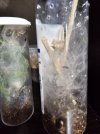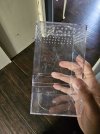Cayden21
New Member
- Messages
- 1
- Location
- Chesterton IN
Is a heat mat a death sentence, I just bought an avic avic and I put a heat mat on her enclosure but I'm very new to owning ts and I'm kinda worriedI keep several different arboreal species of tarantula but not all of them require the same care. The general care and keeping of the various avicularia-type arboreal species differs from all other arboreal and terrestrial species; but it's not complicated.
A little history
I lost my first avicularia sling (at the time it was called Avicularia versicolor, today Caribena versicolor) after a month and a molt, I never knew why. It was devastating for me, and the T. I had been successful with a few terrestrials and even though I thought I had done my research and was ready, something about my keeping wasn't.
I decided I didn't want to give up on arboreal keeping, I needed to learn from my experience. I did a lot more research, adjusted my husbandry and care, and decided to give it a try again. I have been 100% successful keeping various avicularia sp since. It's not complicated or super involved, but there are some basics for arboreals, and more for avicularia sp; but it's easy. Avicularia are not 'dangerous' like old world arboreals can be with medically significant venom, but they can be just as quick.
Orient your care and husbandry around what will make the T most successful, and always be respectful.
Like any species tarantula, you must meet its housing and hydration needs at all times. Always offer clean fresh water. A water dish is a given with any and all tarantula species. The easier for you the water dish is FOR YOU to access, clean and change, the better for your T.
Just like mother nature provides water in the form of rain, you should occasionally drip water into their webbing where they can readily get to it. A small hole or two in the top of the enclosure allows you to drip water in. Avoid spraying water for many reasons; mostly because it startles the crap out of the tarantula and sends them bolting. Pipettes are handy for watering slings and juveniles.
Feed avic slings in or as close to their webbing for best success. You can easily confirm they are feeding, vs prey hiding in the enclosures, and avics are not always the stealthy hunters terrestrial and non-avic arboreals tend to be. I rarely see my avics hunt. Just like any pet, don't overfeed. Ts can go much longer than we can without food and just like a fish tank, it's better to underfeed tarantulas.
If you are comfortable in a t-shirt, your tarantula will likely be comfortable, too.
Avics do not need HIGH humidity, this was a common misconception at one point in the hobby and probably resulted in more avic deaths than under-watering. If you keep the water dish full at all times, and overflow it once every week or two, allowing the substrate to dry between soakings, your T should be fine. Depending on your climate, and time of the year, you may need to do this more often than any set schedule. Get in the habit of always checking your Ts water dish when looking at your T.
EDIT
Another way to stave off excess humidity is ventilation. Avics live in trees where there is good airflow. More ventilation (holes in the enclosure) allows airflow, and will allow humidity to escape the enclosure rather than stifle and potentially kill your avic. See about enclosures below.
Avics do not need HIGH temperature either. Just like most tarantulas, if you are comfortable in a T-shirt, your T will likely be comfortable, too. If supplemental heat is required, you are better off heating the area your T enclosure(s) are in than the single enclosure. Avoid heat mats and heat lights and heat projectors that blow hot air. These will all dry out the enclosure and may irritate, or worse, dehydrate your T.
It's kind of all about the enclosure...
Unlike terrestrial Ts that appreciate substrate depth, arboreals favor above ground and often on the ground. Many arboreal species will burrow as slings; avicularia however do not. Avicularia are true arboreals. An avicularia sling on the ground is not what you want to see, it often means a stressed or troubled avic; but they sometimes do choose to go to ground. I've seen avics and non-avicularia arboreals come to ground to drink from water dishes but in their native lands they see lots of rain, and so does their webbing; plus the ground is where hungry predators are (in the wild.) It's very common for tarantulas to drink from their webbing in the wild so there is no reason you cannot water into their webbing - but don't spray, drip.
Avics in general tend to go to the top of the enclosure, to web and live - you should allow them to make that space exclusively theirs. Top-opening lids tend to wreck webbing and upset slings more than necessary. I avoid Top-opening enclosures for any avicularia over 1/2-3/4" in size.
Here are the features for avicularia enclosures I've found most successful:
Here's a few enclosures I use with good success for avics
- Good cross ventilation
- Taller enclosure (not wide and low)
- Bottom opening enclosure
- Diagonal cork bark from opening to top
- Foliage at middle of cork bark (leave top of enclosure open
- 25-30% substrate depth to enclosure height ratio
- A non disruptive way to open the enclosure
- A feeding port at the top can be handy, but not required
Small n Tall amac boxes, inverted and drilled for avics with plenty of cross ventilation.
-note foliage near top with open areas for the T to web and chillax
View attachment 54264
Here's a 3/4-1" sling proving me wrong, it's at the ground, lol
It's not uncommon for them to bring dirt and stuff up into their webbing for various reasons
View attachment 54265
Look bottom leftlittle sucker
This is a 2x4 tall amac box, inverted
View attachment 54266View attachment 54267
Lifting the top off the base and the T stays in the top, with its bark and webbing and leaves making water dish maintenance easy
This is a 24oz inverted deli cup in a cup lid and base following instructions in Tom Moran's DIY avic enclosure/husbandry video
View attachment 54268
It's basically one deli cup stacked on top of the other with a lid on the inside cup. Holes in the outsider cup and the inside one is cut off allowing 1-1.5" substrate depth. Stacked condiment cups make swapping water dishes easy. The bottom cup is glued to the lid it's sitting on, soil filled in around it.
EDIT
I have since found ways to use top-opening enclosures successfully for avics that I will discuss in a reply below.
Match the enclosure size to the size of the tarantula, smaller is often better
Avics are medium sized arboreals when full grown compared to other arboreals, usually not exceeding 4-5", or 5-6". The largest enclosure an adult avicularia will probably need is something like the Exo Terra Nano Tall, 8x8x12.
Here is Rebecca, our adult Avicularia metallica (Avicularia avicularia morphotype 6 (M6)) in her ETNT
(Avicularia metallica is one of the largest avic species)
View attachment 54271View attachment 54270
Can you go larger? Sure, the T may not fare any better tho and in fact, larger enclosures tend to be problematic. The less your T needs to hunt for foot the more you can control and monitor it's nutrition needs by ensuring it eats when you feed it. The more the T can sense the boundaries of their realm, the more confident and comfortable they are. Tarantulas are solitary, somewhat sedentary creatures and like their space. They tend to be much more comfortable in a studio apartment than a mansion.
Last word about enclosures, truthfully almost any container can be made to work. I've had good success with slings and juveniles in the few enclosures posted here, but there are other keepers using a ton of other containers with equally as much success. Do your research, try things out. Always favor ease of maintenance.
Here's a few tips for first time avic sling keepers:
- Don't drive yourself crazy, obsessing over its care, it's not that complicated
- Do not disturb or stress your sling by checking on it a hundred times an hour (set up a cam if you must)
- (get more than one sling at a time to avoid new tarantula syndrome)
- Don't let the substrate go dry for days on end, avics are not arid species
- Don't over water, let the substrate dry out before wetting it again
- Don't let the water dish dry out!
- Don't just refill a dirty water dish, clean or replace it
- Don't overfeed your T, remove uneaten or unconsumed food items after 24 hours
- Don't go crazy cleaning the enclosure, and stressing out your T in the process
- Don't worry it it doesn't web on day 1 (they sometimes won't web for weeks or months)
- Always be patient, there are seldom any real "tarantula emergencies" saving escapes
- Get the basics right and be consistent
Good avic husbandry need not be complicated, nor stressful, for either the keeper nor the kept.
Get the basics right and everything else becomes less critical.
Just like my juvenile A. avicularia (M1) Mikey here, keep it simple, yo
View attachment 54269


